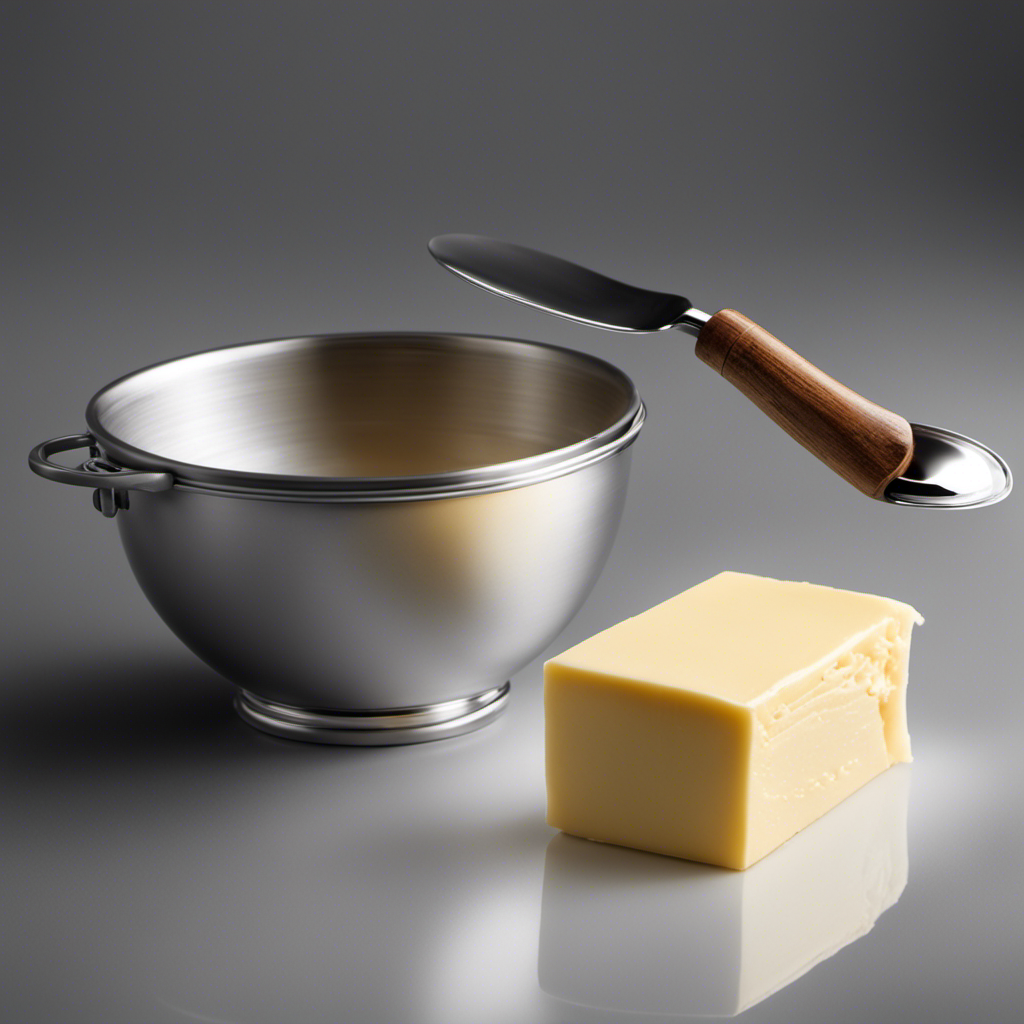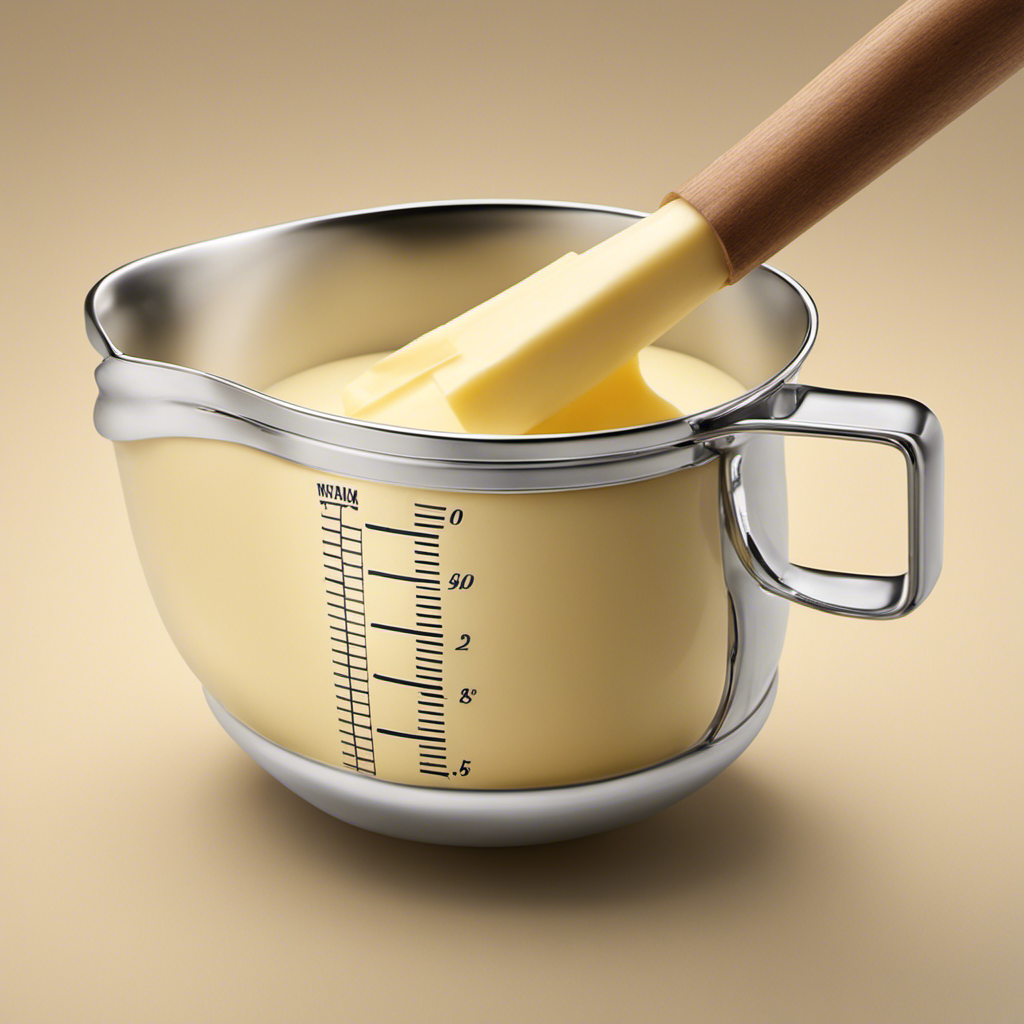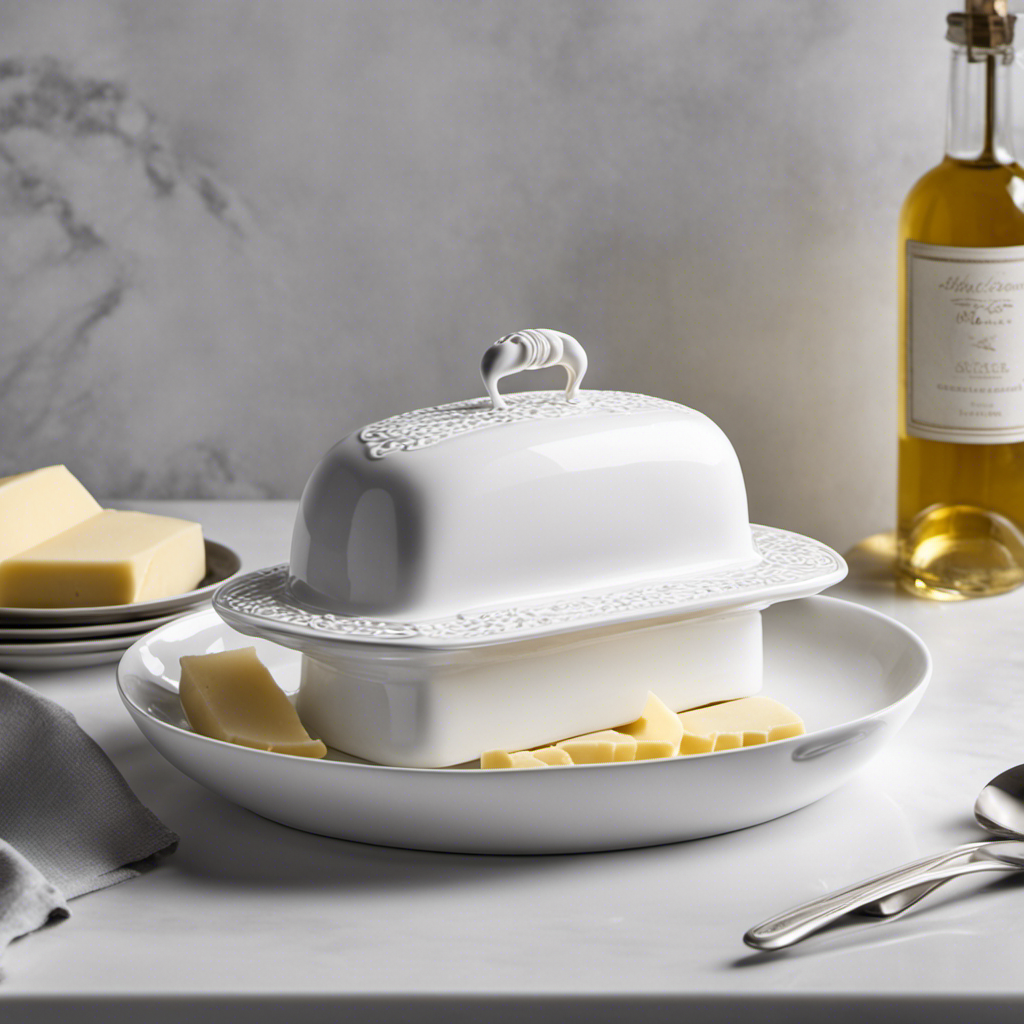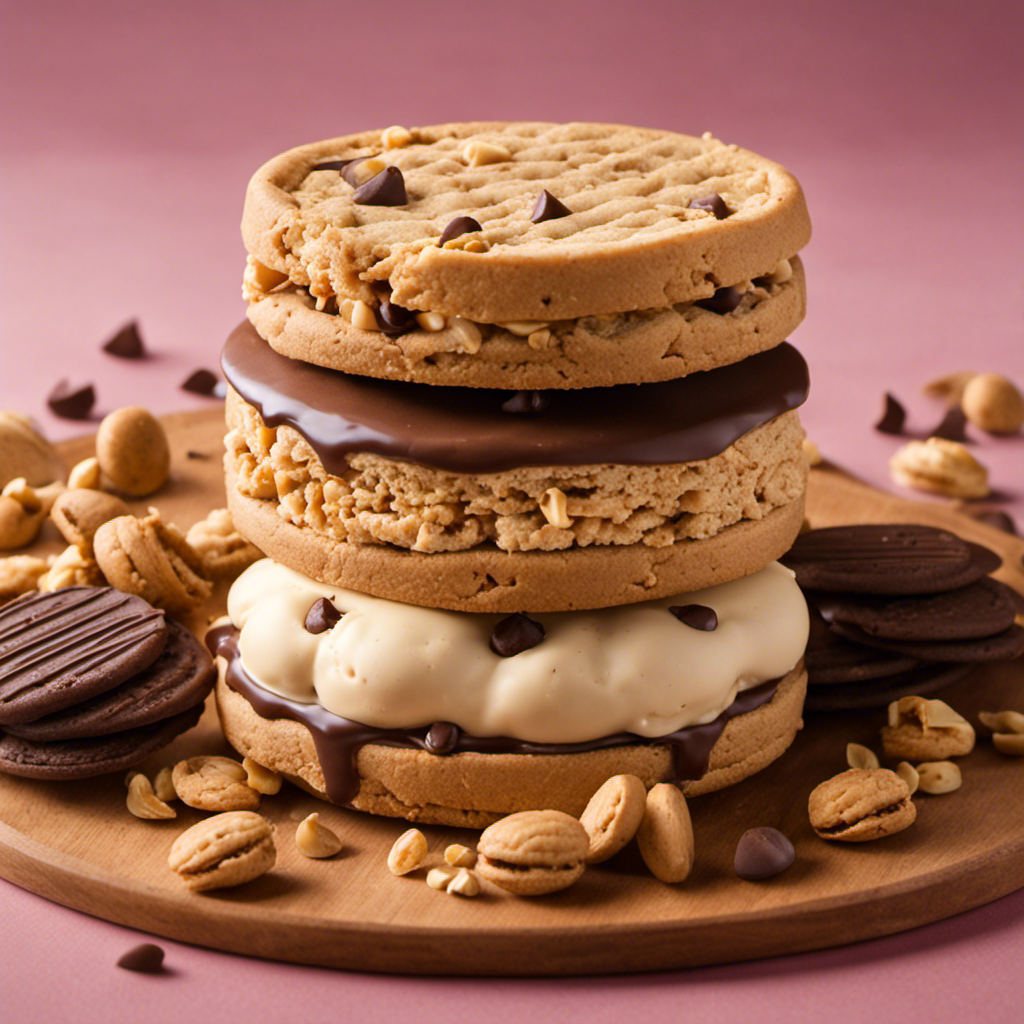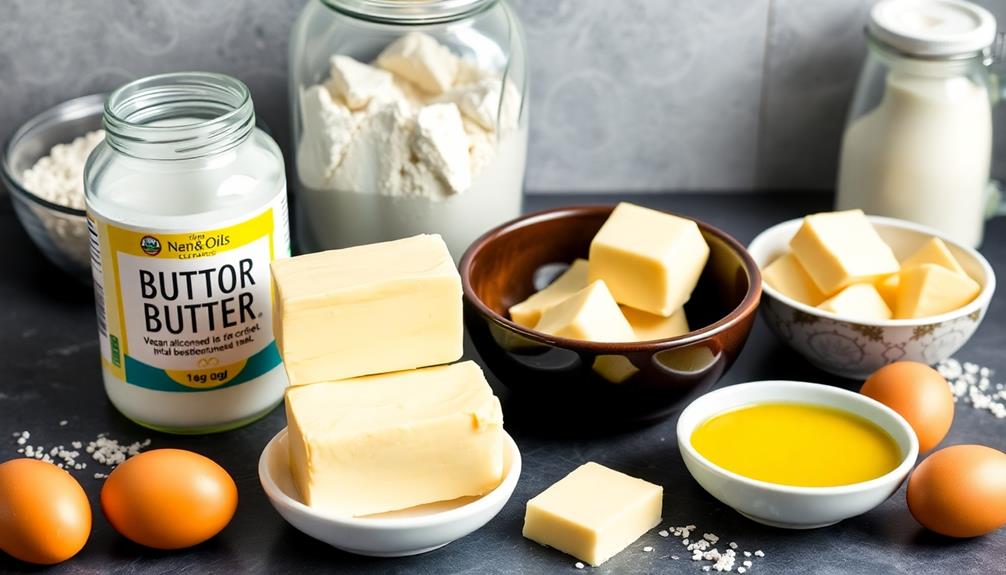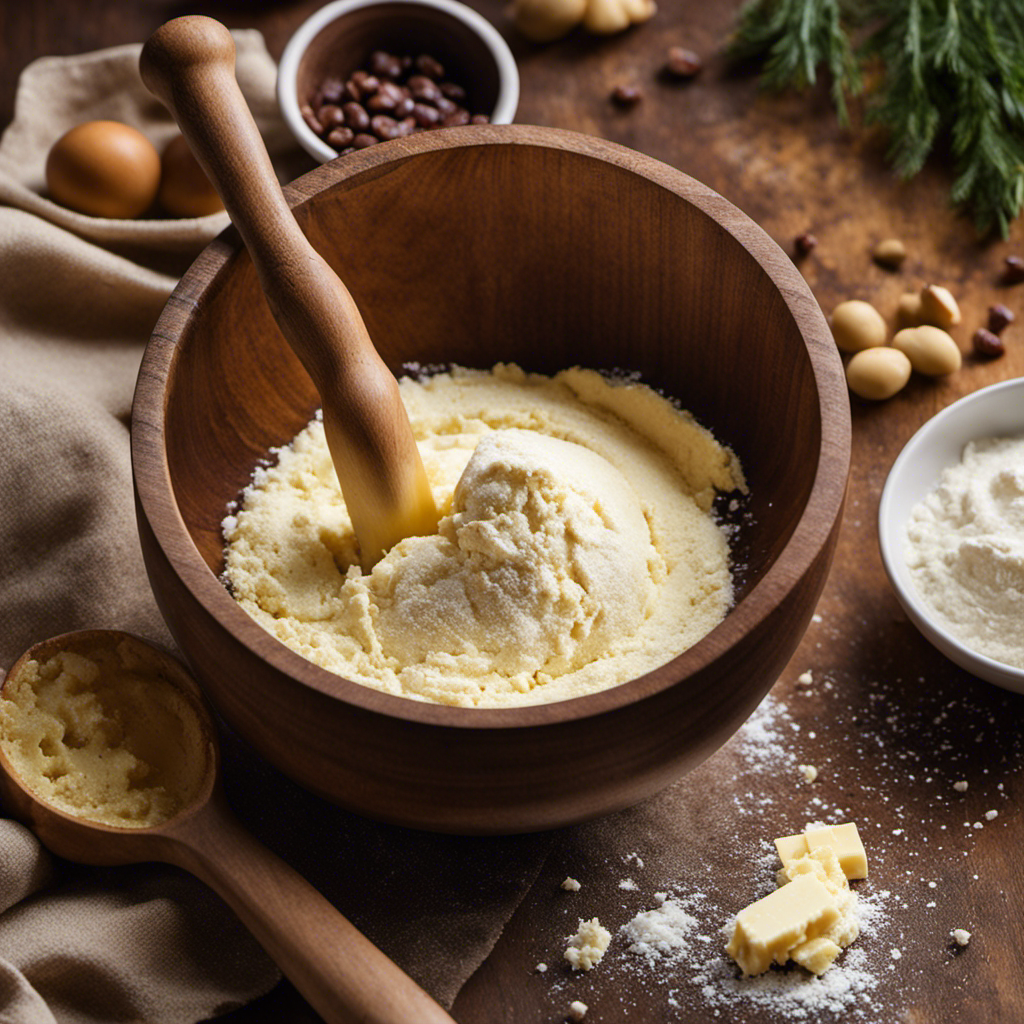As someone who’s passionate about butter, I frequently catch myself pondering the conversion of butter sticks to tablespoons. It’s a query that might perplex experienced bakers as well. However, worry not, as I have thoroughly investigated the realm of butter measurements to provide you with the information you’re looking for.
In this informative article, I will guide you through the process of converting a stick of butter to tablespoons, providing you with a handy conversion guide along the way.
Let’s dive in and uncover the tablespoon measurement in one stick of butter!
Key Takeaways
- Accurate butter measurements are crucial for achieving desired results in baking.
- One stick of butter always equals 8 tablespoons.
- Different types of butter (salted, unsalted, whipped, European, vegan) all have the same tablespoon equivalent.
- Margarine can be used as a 1:1 replacement for butter.
Understanding Butter Measurements
There’s 8 tablespoons in 1 stick of butter.
Understanding the importance of accurate butter measurements in baking recipes is crucial for achieving the desired results. Using too much or too little butter can significantly affect the texture, flavor, and overall outcome of your baked goods.
To properly measure butter for cooking and baking, start by checking the packaging for measurement markings. If there are none, you can use a kitchen scale to weigh the butter or refer to volume measurements.
Softened butter should be measured by packing it into a measuring cup, while cold butter can be sliced or grated for easier measurement. Remember to level off the top of the butter for precise measurements.
Converting Stick of Butter to Tablespoons
When it comes to butter measurement conversions, understanding how many tablespoons are in one stick of butter is essential. As a home cook, I often come across recipes that call for a specific amount of butter in tablespoons rather than sticks.
Knowing the conversion can help me accurately measure and add the right amount of butter to my dishes.
Butter Measurement Conversions
A stick of butter contains 8 tablespoons. Accurate measurement of butter is important in cooking and baking because it can greatly affect the outcome of your recipe. Here are some common mistakes to avoid when measuring butter:
- Eyeballing the measurement: It’s easy to just estimate the amount of butter needed, but this can lead to inconsistent results.
- Using a liquid measuring cup: Butter is a solid, so it should be measured using dry measuring cups or scales.
- Not softening the butter properly: Recipes often call for softened butter, which should be at room temperature for easy measurement and incorporation.
Accurate butter measurements can help ensure that your baked goods turn out perfectly every time. So, next time you’re in the kitchen, remember to measure your butter accurately to achieve the best results.
Tablespoons per Butter Stick
One stick of butter typically contains 8 tbsp. Understanding butter substitutes and the tablespoon equivalents for different types of butter can be helpful in baking and cooking. Here is a table that provides the tablespoon equivalents for various types of butter:
| Type of Butter | Tablespoon Equivalent |
|---|---|
| Salted | 8 tbsp |
| Unsalted | 8 tbsp |
| Whipped | 8 tbsp |
| European | 8 tbsp |
| Vegan | 8 tbsp |
As you can see, regardless of the type of butter, one stick always equals 8 tablespoons. This information is useful when following recipes that call for a specific amount of butter. Whether you prefer salted, unsalted, whipped, European, or vegan butter, you can easily measure them out using the tablespoon equivalent.
Butter Equivalents: Stick to Tablespoon Conversion
To convert a stick of butter to tablespoons, you’ll need to know that there are 8 tablespoons in 1 stick. This is a common measurement used in recipes and cooking. However, there are times when you may need to substitute butter or use alternative butter measurements.
Here are some key points to keep in mind:
-
Butter Substitutes:
-
Margarine: Can be used as a substitute for butter in most recipes.
-
Coconut Oil: Can be used as a vegan-friendly butter substitute.
-
Avocado: Can be mashed and used as a healthier butter alternative.
-
Alternative Butter Measurements:
-
Half Stick: Equal to 4 tablespoons or 1/2 cup.
-
Quarter Stick: Equal to 2 tablespoons or 1/4 cup.
-
1/3 Stick: Equal to 2 and 2/3 tablespoons.
Knowing these substitutes and alternative measurements can come in handy when you run out of butter or need to make adjustments to your recipe.
Calculating Tablespoons in a Stick of Butter
When it comes to baking, precise measurements are crucial for successful results. One common measurement quandary involves converting butter from sticks to tablespoons.
Understanding the conversion rate of tablespoons per stick can help ensure accurate measurements and consistent baking outcomes.
Additionally, knowing common butter substitutes can be helpful for those who may not have butter on hand or prefer to use a different option for dietary or flavor reasons.
Butter Measurement Conversions
There’s a common measurement conversion question: how many tablespoons are in 1 stick of butter? Understanding butter measurements can be confusing, especially when it comes to converting between different units.
Here are a few key points to keep in mind:
-
Butter measurements can vary depending on where you live. In the United States, a stick of butter typically equals 8 tablespoons or 1/2 cup. However, in some European countries, butter is often sold in 250-gram blocks, which is roughly 17.6 tablespoons.
-
If you don’t have a stick of butter on hand, there are common butter substitutes you can use. Margarine, for example, can be used as a 1:1 replacement for butter in most recipes. Other substitutes include coconut oil, vegetable shortening, and even applesauce for a healthier alternative.
Tablespoons per Stick
In the previous subtopic, we discussed various butter measurement conversions. Now, let’s focus on the specific question of how many tablespoons are in 1 stick of butter.
To help you understand the conversion better, I have created a table below:
| Stick of Butter | Tablespoons |
|---|---|
| 1 | 8 |
| 2 | 16 |
| 3 | 24 |
As you can see, each stick of butter is equivalent to 8 tablespoons. So, if a recipe calls for 1 stick of butter, you can use 8 tablespoons as a substitute.
It’s also worth noting that if you need to convert butter measurements to ounces, 1 stick of butter is equal to 4 ounces. This information can be useful when working with recipes that require precise measurements.
I hope this table and information make it easier for you to navigate butter conversions in your cooking and baking endeavors.
Common Butter Substitutes
If you’re looking for alternatives to butter in your recipes, you can try using ingredients like margarine, coconut oil, or applesauce. These common butter substitutes not only add flavor and richness to your dishes but also offer health benefits.
Here are some key points to consider:
-
Margarine: Made from vegetable oils, margarine is a popular choice for baking and spreading on toast. Look for options with no trans fats and lower saturated fat content.
-
Coconut oil: With its unique taste and aroma, coconut oil is a versatile substitute. It contains medium-chain triglycerides, which are believed to boost metabolism and promote weight loss.
-
Applesauce: In baking, applesauce can replace butter to reduce the overall fat content. It adds moisture and natural sweetness to your recipes while providing vitamins and fiber.
Tablespoon Measurement in One Stick of Butter
You’ll find 8 tablespoons in one stick of butter. Understanding butter substitutes is important for those who want to reduce their intake of saturated fats or for those who have dietary restrictions. Using tablespoons for butter measurement offers several benefits. Firstly, it provides a convenient and precise way to measure butter, especially when a recipe calls for a specific amount. Secondly, it allows for easy substitution when using butter substitutes, as most butter substitutes come in tablespoon measurements. Lastly, using tablespoons helps maintain consistency in baking and cooking, ensuring that the right amount of fat is incorporated into the recipe. Below is a table illustrating the equivalent measurements of tablespoons in sticks of butter:
| Sticks of Butter | Tablespoons |
|---|---|
| 1 | 8 |
| 2 | 16 |
| 3 | 24 |
| 4 | 32 |
Stick of Butter to Tablespoon Conversion Guide
In my previous discussion, I explained the measurement of a tablespoon in a stick of butter. Now, let’s delve into the topic of converting a stick of butter into tablespoons.
This conversion guide will provide you with the necessary information to easily measure butter in tablespoons. Here’s what you need to know:
- A standard stick of butter is equivalent to 8 tablespoons.
- Each tablespoon of butter is equal to 1/8th of a stick.
- To convert a specific amount of butter into tablespoons, simply multiply the number of sticks by 8.
Frequently Asked Questions
Are There Any Other Measurements for Butter Besides Tablespoons and Sticks?
There are indeed other measurements for butter besides tablespoons and sticks. When it comes to conversions for butter measurements, you can also find recipes that use ounces, grams, or cups as units of measurement.
How Do I Measure Butter if I Don’t Have a Tablespoon or a Stick?
If I don’t have a tablespoon or a stick, there are alternative ways to measure butter. I can use butter substitutes or eyeball it based on the package markings. It’s all about finding what works best for you!
Can I Use Margarine or Oil as a Substitute for Butter in Recipes?
Sure, you can use margarine or oil as a substitute for butter in recipes. However, keep in mind that margarine may have a different taste compared to butter. Additionally, different types of oils have their own pros and cons when used as substitutes for butter.
How Many Teaspoons Are in a Tablespoon of Butter?
In a tablespoon of butter, there are 3 teaspoons. This is a useful conversion to know when measuring butter for recipes. It ensures accuracy and helps achieve the desired flavor and texture.
Is It Possible to Freeze a Stick of Butter and Still Use It for Baking?
Yes, it is possible to freeze a stick of butter and still use it for baking. Freezing butter can help extend its shelf life, and it is important to store it properly in an airtight container to maintain its quality.
Conclusion
So there you have it, folks! Now you know that there are 8 tablespoons in 1 stick of butter.
Armed with this knowledge, you’ll be able to confidently follow any recipe that calls for butter measurements.
Remember, when it comes to cooking, knowledge is power. So go forth and whip up some delicious dishes with the perfect amount of butter!
As the saying goes, ‘Knowledge is butter than ignorance.’
Happy cooking!
